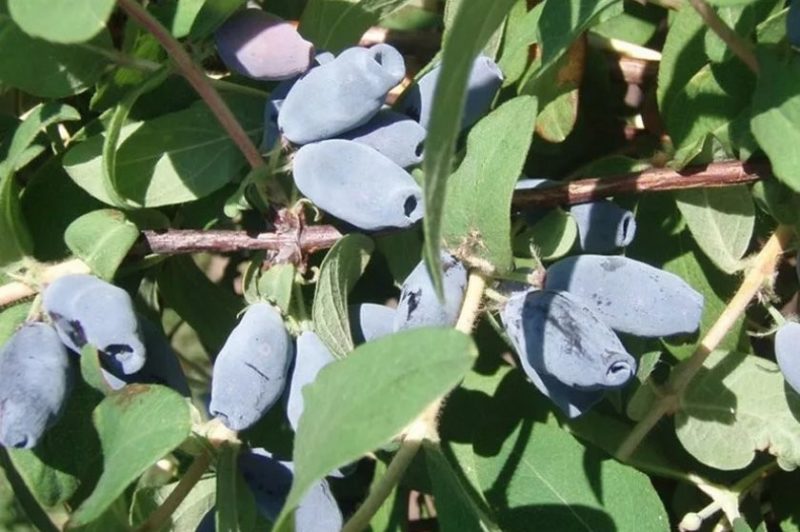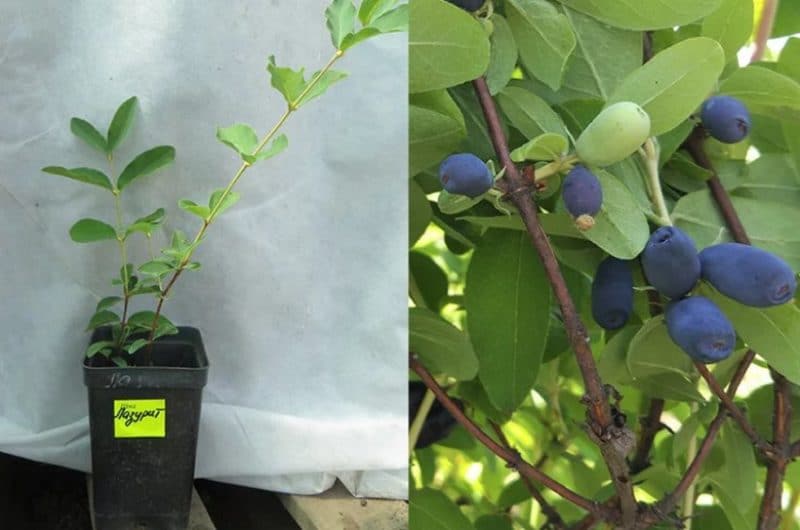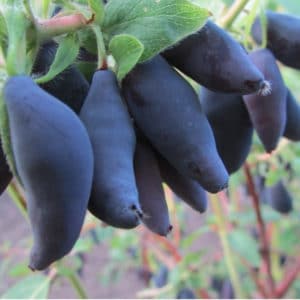Resistant honeysuckle variety Lapis lazuli with excellent taste
Lapis lazuli is one of the most popular honeysuckle varieties among Russian gardeners. It gained recognition due to the possibility of cultivation in various regions, resistance to diseases and pests, excellent taste and ease of care. We will talk about the characteristics of Lapis lazuli, its advantages and disadvantages, the rules of agricultural technology and the difficulties that sometimes arise when growing crops, in this article.
Description of the honeysuckle variety Lazurit
Information about the main characteristics of the crop, the taste of the fruit and the timing of their ripening, yield, resistance to climatic conditions, as well as a number of other information about the plant will help you get the most complete picture of the variety and appreciate it.

Origin and development
The fruit variety of honeysuckle Lazurit was bred by Ekaterinburg breeders, employees of the South Ural Research Institute of Horticulture and Potato Growing.
In 1999, the State Commission of the Russian Federation for Testing and Protection of Breeding Achievements approved the crop for cultivation, recommending it for all regions of the country.
Characteristics, appearance and taste
Lapis lazuli belongs to the medium-sized and partially self-fertile varieties of honeysuckle.
The height of the bush is 1.7-2 m. Curved branches with pubescence form a compact, slightly compressed crown. Large, wrinkled, egg-shaped leaf plates are covered with light hair, grow on short petioles, and are dark green in color.The shrub blooms with large pale pink flowers.
The length of the fruit reaches 2 cm. Each elongated oval-shaped berry weighs on average 1.4-1.5 g. The fruits are covered with a thin purple peel, on which there are light spots of a waxy coating.
The pulp has a delicate structure and a magnificent sweet taste with a slight hint of sugariness, slight sourness and a subtle blueberry aroma without bitterness. Professional tasters rate the taste qualities of this honeysuckle variety at 4.8-5 points on a 5-point scale.
Reference. Lapis lazuli fruits contain up to 64 g of ascorbic acid, large amounts of iron, potassium, phosphorus, magnesium, and useful organic acids.
Features of application
The berries of the plant are edible; the variety is classified as dessert. Its use is based precisely on the high taste qualities of the fruit. They are eaten both fresh and dried, frozen or processed.
Prepared from berries:
- jams;
- juices;
- compotes;
- jam;
- jelly;
- wine that tastes as good as grape wine;
- fruit drinks.
There is an opinion that honeysuckle Lapis lazuli has medicinal properties and is used in the creation of medicines, as well as as a means of traditional medicine:
- to improve appetite;
- for colds;
- to support the body during exhaustion;
- for hypertension;
- to improve blood circulation.
The Lapis Lazuli variety is not without decorative properties and can become a worthy decoration of the landscape both when planted individually and in group plantings.
Productivity and fruiting
The crop begins to bear fruit 2-3 years after planting and continues to produce berries for 20-25 years if care recommendations are followed.
The plant cannot boast of high yield: up to 2 kg of berries are harvested from 1 bush.
Ripening period
Lapis lazuli is a medium-ripening honeysuckle variety. The berries begin to ripen in mid-June, and fruiting continues for a month.
Resistance to diseases and pests
Lapis lazuli is characterized by high resistance to fungal diseases and most insects, however, especially if the rules of agricultural technology are violated, the plant may suffer from fungus, aphids, scale insects and a number of other pests.
Resistance to cold and drought
The variety is characterized by increased frost resistance, successfully tolerating frosts and temperatures down to -40°C.
During the dry period, the plant continues to develop successfully, provided that the watering regime is followed.
Suitable regions
Resistant to heat and cold, Lapis lazuli takes root well in any region of the country, but develops especially well in the climate:
- middle zone;
- Altai;
- Ural;
- Siberia.
The variety, undemanding to climatic conditions, gives higher yields where there are no:
- prolonged drought;
- very severe frosts.
Advantages and disadvantages

Lapis lazuli has many advantages, of which it is worth noting first of all:
- High resistance to low temperatures.
- Drought resistance.
- Great berry taste.
- Large fruit.
- Resistance to diseases and pests.
- Average ripening time.
- The versatility of fruit use.
- Decorative appearance of the bush.
The disadvantages include:
- Relatively low yield.
- Fruit shedding (above average).
- Requirement for pollinators.
- Possibility of re-blooming.
Difference from other varieties and hybrids
Lapis lazuli is distinguished from other varieties of honeysuckle by:
- especially pleasant taste of fruits;
- mid-ripening;
- increased resistance to low temperatures.
In terms of productivity, Lapis Lazuli is inferior to many other varieties of honeysuckle and has the disadvantage of significant shedding.
Agricultural technology
In order for the plant to successfully take root in a new place, apply autumn landing.
Compliance with recommendations for carrying out agrotechnical measures ensures a timely harvest of tasty fruits.
Choosing a place in the garden and preparing holes
When choosing a suitable place for a shrub, you should pay attention to:
- Illumination. The tops of the bushes need to be provided with good light for most of the day.
- Humidity. The depth of groundwater must be at least 2 m so that the roots of the plant do not suffer from excess moisture.
At a distance of 1.5 m from each other, planting holes are formed with a depth of 20-25 cm and a size of 40x60 cm, at the bottom of which a drainage layer of broken brick, crushed stone or expanded clay is placed.
Important! To protect the root system and branches from overheating, it is recommended to plant honeysuckle close to other types of fruit bushes that are short in height.
Preparing for landing
Before planting, the roots of seedlings are disinfected:
- immersing for 15-20 minutes in a pale pink solution of potassium permanganate;
- treating with fungicidal preparations (“Fitosporin”, “Baktofit”).
Soil requirements
Before planting, the soil on the site is dug up, adding 10 kg of humus or compost per 1 m² of area to improve fertility.
If the soil is highly acidic, deoxidize it by adding:
- lime;
- wood ash.
The layer of soil removed when digging a hole is mixed with 40 g of potassium fertilizer and 50 g of superphosphate.
Dates, scheme and rules of planting
The crop is planted in the fall, before the first frost, depending on the region:
- in the middle zone - from late September to mid-October;
- in the northern regions, in Siberia and the Urals - from late August to mid-September;
- in the south - from early October to early November.
At the bottom of the prepared holes, located at a distance of 1.5 m from each other, a hill is formed from garden soil in accordance with the size of the root system of the seedlings.
The tree is positioned so that its roots are evenly distributed on the surface of the mound. Sprinkle the top with a layer of soil mixed with pre-applied fertilizers. Make sure that the root collar is buried no more than 3 cm.
To avoid the formation of air pockets, the soil is lightly compacted. Water the planted plant in several passes, adding a bucket of water under the bush in total. The tree trunk circle is covered with a layer of mulch to retain moisture in the soil.
Features of cultivation
To obtain a high-quality Lapis Lazuli harvest, a plant with a compact root system must be provided with proper watering - so that moisture penetrates directly under the root and reaches all its branches.
The crop especially needs moisture during flowering and during the formation of berries:
- take settled water, preferably at room temperature;
- water the bush as the soil dries 40-50 cm deep;
- Watering is carried out in portions, waiting until the moisture is absorbed into the soil.
To sufficiently moisten an adult honeysuckle bush, it is necessary to use up to 20 liters of water per watering.
In the fall, before the first frost, the bushes are pruned, removing broken branches.At the end of April - beginning of May, the plant is pruned again, removing frozen, diseased and broken shoots, as well as forming a crown. For this:
- cut out the branches growing inside the bush, leaving 5 skeletal shoots in the first year;
- in the future, the crown is inspected and thinned annually, preventing thickening.
For the first time after planting in a permanent place, Lapis lazuli, planted in pre-fertilized soil, is fed a year later (in spring), adding 1 m² soil 20 g of urea or other nitrogen fertilizer.
It is useful to do the second feeding during flowering by spraying the foliage with an ash solution (200 g of wood ash per bucket of water).
The third time the procedure is appropriate during the fruiting period. The soil in the tree trunk circle is enriched by adding 50 g:
- superphosphate;
- potassium salt.
Pollinators
Lapis lazuli is 27% self-fertile. To obtain a good harvest, the plant needs pollinators, the most suitable of which are:
- Vlada;
- cubic zirconia;
- Fire opal.
They are planted in groups (at least 2-3 bushes) at a distance of 2 m from the pollinated shrubs.
Disease and pest control
Despite the fact that the crop is highly resistant to fungal and insect damage, it is not always possible to completely avoid problems. If they occur, appropriate measures are taken.
Spray the bush with Actellika solution (in a ratio of 2 ml per 2 liters of water) to get rid of:
- aphids;
- scale insects;
- leaf rollers;
- insect larvae.
To cope with fungal diseases, apply treatment with the drug “Baktofit”, dissolving 20 ml of the product in 10 liters of water:
- when affected by rust and late blight, spray the bushes;
- from septoria and powdery mildew, water the soil in the tree trunk circle.
Before planting, the roots are disinfected by soaking in a solution (1 ml of product per 1 liter of water) for 15 minutes.
Important! “Baktofit” refers to biological preparations, the use of which is permissible at any stage of the honeysuckle growing season.
Preparing for winter
Lazurit honeysuckle, bred in the Urals, is characterized by increased winter hardiness and does not require winter shelter.
To prepare for winter use:
- autumn pruning of damaged branches so that in winter the plant does not expend energy on their restoration;
- mulching the tree trunk circle with sawdust, peat, dry leaves.
Reproduction
The culture is propagated in three ways:
- By rooting the stems, placing the lower branches in grooves 10 cm deep, covering them with soil and regularly moistening them until germination. New shoots that appear are replanted.
- By cuttings, rooting cuttings prepared in the fall in the winter, and planting them in the garden in the spring.
- By dividing the bushes, dividing them into equal parts with a sharp shovel.
Difficulties in growing
A variety that is only 27% self-fertile may not produce a harvest. In this case it is necessary:
- increase the number of pollinating plants growing nearby;
- To attract insects during flowering, treat the bushes with a sweet solution, adding 2 tbsp per 10 liters of water. l. Sahara.
If the plant's yield decreases, you need to perform anti-aging pruning of the bushes and repeat it every 2-3 years.
Harvesting

To prevent the harvest of Lapis Lazuli, which is a variety with high fruit shedding, from being partially lost, it is necessary to start collecting berries immediately after they ripen.
The fact that the fruits have reached maturity is indicated by the uniform purple color of their skin.
Once this happens:
- Place a clean plastic film under the bush.
- Shake the bush, trying to get all the berries off it.
- The harvested crop is poured in a thin layer into pre-prepared shallow containers.
When transporting Lapis Lazuli honeysuckle fruits, care must be taken not to damage their delicate pulp.
Tips and reviews from experienced gardeners
Gardeners leave positive reviews about Lapis Lazuli honeysuckle.
Elena, Omsk: “In my garden I grow 2 bushes of Lapis Lazuli honeysuckle. I noticed that the yield of the crop depends on the planting location: in an open area the bush freezes and bears less fruit. In the third year after planting, I collected 0.6 kg of berries from one bush.”
Natalya, Chelyabinsk: “I am happy to cultivate the Lazurit honeysuckle variety in my garden. The plant is unpretentious, almost never gets sick, and tolerates cold well. Although the harvest is small, the taste of the berries is simply amazing, special, and they make excellent jam.”
Conclusion
Honeysuckle Lapis lazuli with its main advantages - excellent taste and resistance to cold - is a good choice for a gardener who wants to grow a crop on his plot, especially if the region is characterized by harsh climatic conditions.
Compliance with the rules of agricultural technology will allow you to harvest a small, but unusually tasty harvest in a timely manner.